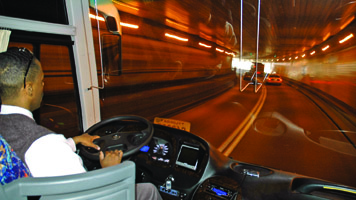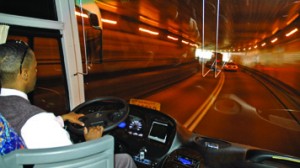
Accurate in-vehicle coaching promotes positive change
by David Coleman

As bus and coach drivers are ultimately responsible for behavior that impacts fleet crash rates, fuel consumption, and wear and tear on the vehicles, collectively they represent the single biggest factor in a safe, productive and efficient bus operation.
The question is are operators really providing the best tools and technology for drivers to positively change their performance, improve their safety as well as the company bottom line? The driver is the single biggest factor in a safe, productive and efficient bus operation. Since they are the ones doing the driving, naturally bus and coach drivers are ultimately responsible for behavior that impacts fleet crash rates, fuel consumption, and wear and tear on the vehicles. The question is are operators really providing the best tools and technology for drivers to positively change their performance, improve their safety as well as the bottom line of their company?
For the last 20 years, in-vehicle technology available for buses and shuttles has captured data on driver behaviors such as harsh acceleration and braking, but rarely has the technology effectively changed the underlying driver attitudes and behaviors that contribute positively to fleet operating expenses. Simply capturing driving event data and informing management systems is not enough to change the attitudes and activities that drive consequences and cost.
Typically this information has been available for fleet maintenance processes not set up to positively coach the drivers. Maintenance professionals can determine which vehicles have the worst fuel performance and wear-and-tear, but they are not in the position to address the fundamental driver behaviors that contribute to the cost.
What if ...
What if we provide in-the-moment alarms in the bus or coach and alert drivers when they are making a specific mistake, for instance, when they are following too close, drifting from the proper lane or exceeding the fleet speed? Do these event avoidance systems create lasting skills for driver, or do they allow drivers to get away with a history and pattern of unsafe practices knowing that the warning system should “wake them up” in time to avoid a crash?
At best, they are a last-ditch event avoidance system when driver skills have failed, and they provide no benefit to fuel and life-cycle expenses.
If the goal is to change driving behavior to reduce crash, fuel, and other performance costs, having the vehicle data is not enough, and active warning systems focus only on in-the-moment event avoidance.
So how do we change the driver? First, you need to put the tools in the hands of the person who is behind the wheel, not just a supervisor or management for punitive driver intervention.
What tools do your drivers have today to help them be the best? If you are like most fleets, you may do some skills training and maybe some remedial training after an event or based on risk profiling. Given the rapid change in technology in the last few years, is this really the best we can do given the risk and cost of driving?
The essence of becoming the best at any activity and staying the best is getting constant feedback on how you are progressing and your performance relative to the goal. The accuracy of that feedback is critically important; it needs to be unbiased and relate to your overall goals and objectives, not just bits and pieces of your performance. And the best performance is attained when that feedback is instantaneous. Think about video games, learning to swim or practicing piano. The best skills are developed and sustained in an environment that includes real-time performance feedback. Imagine how good your drivers would be if they received real-time feedback relative to your optimal driving safety and performance goals. Do they know what being the best driver in your vehicles means? Do you really even know who your best and worst drivers are?
At GreenRoad we provide drivers with an in-vehicle, real-time tool that is with them every mile of their driving day, providing simple, clear feedback on their driving relative to their corporate safety and performance goals. We provide an accurate, unbiased “coach” with objective real-time feedback in a precise way and create the safest, most cost efficient drivers. Absent is the “spying” and “big-brother” aspect of prior generation tools – we give drivers the personal autonomy to manage their driving against the corporate goals for performance and safety, empowering them to make changes before management intervenes. We immediately transform driving culture, delivering the best drivers on the road. GreenRoad returns a positive ROI within months by dramatically reducing crashes and providing better fuel economy and reduced vehicle life-cycle costs.
Considering the amount of time most employees spend behind the wheel, it’s important that the feedback itself be unobtrusive, friendly and effective. In-vehicle sound and/or voice feedback can be annoying, distracting and obtrusive. Remember the “Your door is ajar” nuisance from the 1980s? In-vehicle video surveillance systems have driver and customer privacy concerns, cultural impacts on your organization from a big brother standpoint, and the delay between video capture and coaching results in an ineffectual feedback loop. Would you work for an organization that put a video camera in your office waiting to catch you doing something?
At GreenRoad we get high marks from drivers who appreciate the autonomy to self-correct and who can relate to our unbiased coaching from a display that indicates their performance in real-time against the corporate driver policy and goals. Drivers are only coached when they make a maneuver that departs from what is optimal for their vehicle. The best drivers receive very little feedback; the rest are coached in real-time until they become the best.
Secondary to the in-vehicle feedback is real-time online reporting for management. This creates a complete loop of driving performance information that can be shared, analyzed and discussed. It creates specific unbiased coaching and training plans between management, supervisors, and drivers.
The final step is cultural awareness. The best drivers work for organizations that embrace self-directed performance measurement and provide the autonomy to work towards clearly stated driving performance and safety goals. At GreenRoad we provide the tools for drivers and their employers to create and maintain a culture of driving excellence that has driver safety at the forefront and fuel and lifecycle cost reductions at the backend. I welcome your feedback, feel free to contact me. For more information, please see www.greenroad.com. BR
David Coleman joined the GreenRoad team in January of 2008 and is responsible for implementing the business development strategy for GreenRoad. David has been actively involved in the automotive technology industry for 20 years.
